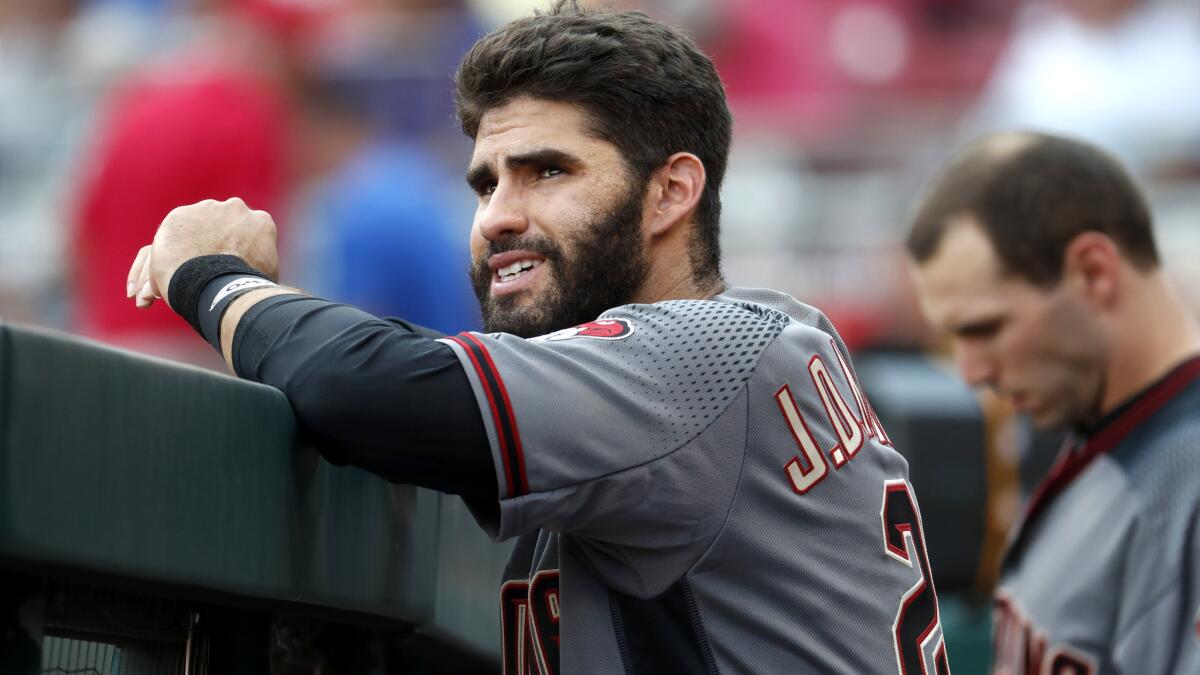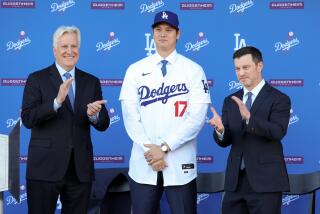MLB agent: ‘There is a rising tide among players for radical change. A fight is brewing’

- Share via
One day after commissioner Rob Manfred shrugged off the sluggish free-agent market for Major League Baseball players this winter as a blip, and one week after Dodgers closer Kenley Jansen suggested players ought to consider whether to strike, one of baseball’s most prominent agents issued a manifesto Friday that hinted players might not simply ride out the remaining four years of the current collective bargaining agreement.
“The players are upset,” wrote Brodie Van Wagenen, co-head of CAA Baseball. “No, they are outraged. … Their voices are getting louder and they are uniting in a way not seen since 1994.”
That was the year of baseball’s last player strike. The calendar has turned to February, and more than 100 players remain available in free agency, including such stars as Jake Arrieta, Yu Darvish, Eric Hosmer and J.D. Martinez.
Van Wagenen raised the possibility of a boycott in spring training.
“There is a rising tide among players for radical change,” he wrote. “A fight is brewing. And it may begin with one, maybe two, and perhaps 1,200 willing to follow.”
Manfred, speaking Thursday at the owners’ meetings in Beverly Hills, cited a variety of factors for the slow market: “different players, different quality of players, different GM’s, different decisions, the new basic agreement, different agents who have particular prominence in a particular market in terms of who they represent, those factors and probably others I can’t tick off the top of my head.”
Added Manfred: “Just like there have been some markets where the lid got blown off in terms of player salary growth, I think economics would suggest occasionally you’re going to have some that are going to be a little different, not quite as robust.”
The players are increasingly skeptical about financial restraint in a sport in which annual revenue has grown to $12 billion, in particular the notion that the rise of analytics has driven owners to limit their bids in free agency. Van Wagenen used the phrases “feels coordinated” and “suspicion of institutional influence” as code words for collusion, which Manfred has denied.
“Many club presidents and general managers with whom we negotiate are frustrated with the lack of funds available to sign the plethora of good players still available,” Van Wagenen wrote. “Even the algorithms that have helped determine player salaries in recent years are suggesting dramatically higher values than owners appear willing to spend.”
The immediate battle for the players might be internal. With the owners maximizing their incentives to reduce spending under the new collective bargaining agreement, the players might need to decide whether to join forces behind executive director Tony Clark or seek new leadership. Many agents objected to what they considered a lack of input when the union negotiated the agreement that now is squeezing their clients.
It is no surprise when agent Scott Boras, who is comfortable speaking publicly and provocatively, criticizes owners for their lack of spending. It is astonishing when Van Wagenen, co-head of an agency that seldom says a word publicly, issues a blistering statement.
And it might be no coincidence that the union is advertising for a director of external affairs, a position that the ad says would “play a key strategic role in growing and protecting the reputation of the organization” and would “be responsible for the organization’s overall messaging and communication strategy.”
Clark, who has declined to make any conclusions about the market in his few public comments this winter, issued a statement later Friday, after the statements of Van Wagenen and another agent, Joshua Kusnick.
“For decades free agency has been the cornerstone of baseball’s economic system and has benefited players and the game alike,” Clark said in his statement. “Each time it has been attacked, players, their representatives and the [Major League Baseball Players] Association have united to defend it. That will never change.”
Our Times column Thursday focused on whether the increasing number of teams playing not to win — even as a strategy to win in future years — might pose a problem for the 30-team league. Attendance has declined in each of the last three seasons, down to its lowest level since 2002.
“That is why attendance is down,” one prominent agent texted in response to the column. “There are only 18 teams in the league.”
Follow Bill Shaikin on Twitter @BillShaikin
UPDATES:
1:50 p.m.: This article has been updated statements from Tony Clark, executive director of the Major League Baseball Players Assn., and player agent Joshua Kusnick.
This article was originally published at 10 a.m.
More to Read
Go beyond the scoreboard
Get the latest on L.A.'s teams in the daily Sports Report newsletter.
You may occasionally receive promotional content from the Los Angeles Times.











